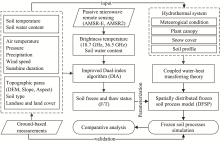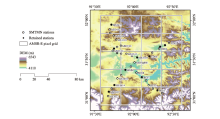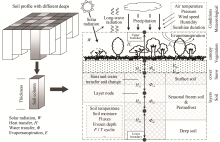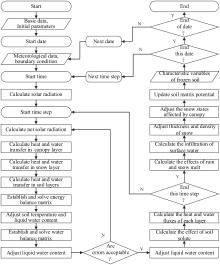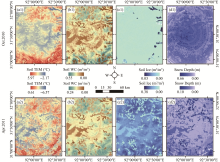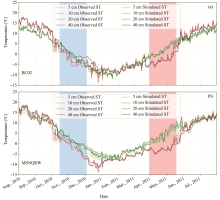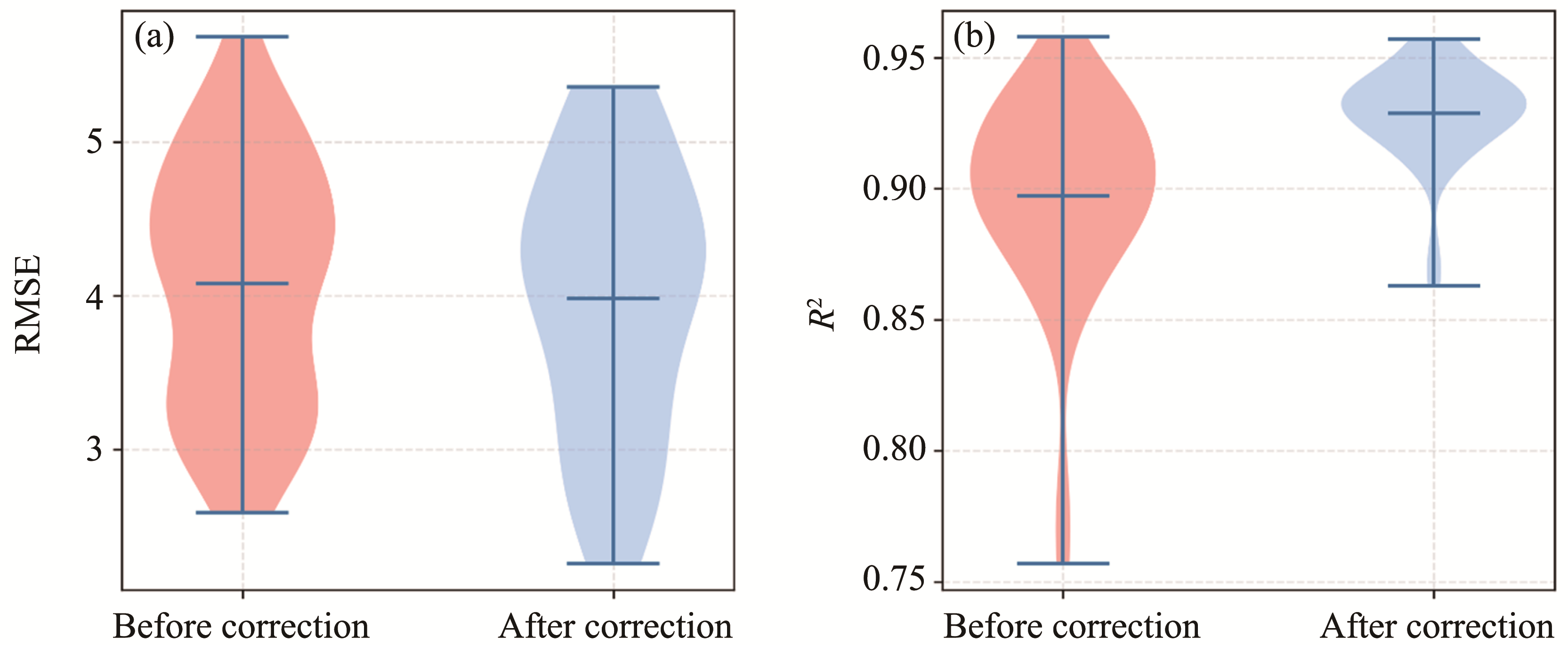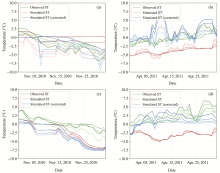Sciences in Cold and Arid Regions ›› 2020, Vol. 12 ›› Issue (6): 404–417.doi: 10.3724/SP.J.1226.2020.00404
Coupling numerical simulation with remotely sensed information for the study of frozen soil dynamics
HuiRan Gao1,2,WanChang Zhang1( )
)
- 1.Aerospace Information Research Institute, Chinese Academy of Sciences, Beijing 100094, China
2.University of Chinese Academy of Sciences, Beijing 100049, China
| Cao MS, Zhang TJ, 1997. Monitoring terrain soil freeze/thaw condition on Qinghai plateau in spring and autumn using microwave remote sensing. Journal of Remote Sensing, 1(2): 139-144. (in Chinese) | |
|
Cao W, Sheng Y, Wu JC, et al., 2017. Spatial variability of permafrost soil-moisture on the slope of the Qinghai-Tibet Plateau. Advances in Water Science, 28(1): 32-40. DOI: 10. 14042/j.cnki.32.1309.2017.01.004. (in Chinese)
doi: 10. 14042/j.cnki.32.1309.2017.01.004. |
|
|
Chai LN, Zhang LX, Zhang YY, et al., 2014. Comparison of the classification accuracy of three soil freeze-thaw discrimination algorithms in China using SSMIS and AMSR-E passive microwave imagery. International Journal of Remote Sensing, 35(21-22): 7631-7649. DOI: 10.1080/01431161.2014.975376.
doi: 10.1080/01431161.2014.975376 |
|
| Chen RS, Kang ES, Ding YJ, 2014. Some knowledge on and parameters of China's alpine hydrology. Advances in Water Science, 25(3): 307-317. (in Chinese) | |
| Chen RS, Lv SH, Kang ES, et al., 2006 A Distributed Water-Heat Coupled (DWHC) model for mountainous watershed of an inland river basin (II): Model Results Using the Measured Data at the Meteorological & Hydrological Stations. Advances in Earth Science, 21(8): 806-818. (in Chinese) | |
| Ding YJ, Ye BS, Liu SY, et al., 2000. Large scale performafost hydrology monitoring and study in Tibetan Plateau. Chinese Science Bulletin, 45(2): 208-214. (in Chinese) | |
| Flerchinger G, Saxton K, 1989. Simultaneous heat and water model of a freezing snow-residue-soil system I. Theory and development. Transactions of the ASAE, 32: 0565-0571. | |
|
Flerchinger GN, Reba ML, Link TE, 2015. Modeling Temperature and Humidity Profiles within Forest Canopies. Agricultural and Forest Meteorology, 213: 251-262. DOI: 10.1016/j.agrformet.2015.07.007.
doi: 10.1016/j.agrformet.2015.07.007 |
|
|
Flerchinger GN, Reba ML, Marks D, 2012. Measurement of surface energy fluxes from two rangeland sites and comparison with a multilayer canopy model. Journal of Hydrometeorology, 13(3): 1038-1051. DOI: 10.1175/JHM-D-11-093.1.
doi: 10.1175/JHM-D-11-093.1 |
|
|
Fuchs M, Campbell GS, Papendick RI, 1978. An analysis of sensible and latent heat flow in a partially frozen unsaturated soil. Soil Science Society of America Journal, 42(3): 379. DOI: 10.2136/sssaj1978.03615995004200030001x.
doi: 10.2136/sssaj1978.03615995004200030001x |
|
|
Gao B, Yang DW, Qin Y, et al., 2018. Change in frozen soils and its effect on regional hydrology, upper Heihe basin, northeastern Qinghai-Tibetan Plateau. The Cryosphere, 12(8): 657-673. DOI: 10.5194/tc-2017-158.
doi: 10.5194/tc-2017-158 |
|
|
Gao HR, Nie N, Zhang WC, et al., 2020. Monitoring the spatial distribution and changes in permafrost with passive microwave remote sensing. ISPRS Journal of Photogrammetry and Remote Sensing, 170: 142-155. DOI: 10.1016/j.isprsjprs.2020.10.011.
doi: 10.1016/j.isprsjprs.2020.10.011 |
|
|
Gao HR, Zhang WC, Chen H, 2018. An improved algorithm for discriminating soil freezing and thawing using AMSR-E and AMSR2 soil moisture products. Remote Sensing, 32(2): 565-571. DOI: 10.3390/rs10111697.
doi: 10.3390/rs10111697 |
|
|
Guglielmin M, Donatelli M, Semplice M, et al., 2018. Ground surface temperature reconstruction for the last 500 years obtained from permafrost temperatures observed in the SHARE STELVIO Borehole, Italian Alps. Climate of the Past, 14(6): 709-724. DOI: 10.5194/cp-2017-23.
doi: 10.5194/cp-2017-23 |
|
| Guo DL, Wang HJ, 2013. Simulation of permafrost and seasonally frozen ground conditions on the Tibetan Plateau, 1981-2010. Journal of Geophysical Research Atmospheres, 118(11): 5216-5230. | |
|
Jin HJ, Li SX, Wang SL, et al., 2000. Impacts of climatic change on permafrost and cold regions environments in China. Acta Geographica Sinica, 55(2): 161-173. DOI: 10. 3321/j.issn:0375-5444.2000.05.004. (in Chinese)
doi: 10. 3321/j.issn:0375-5444.2000.05.004. |
|
|
Jin R, Li X, Che T, 2009. A decision tree algorithm for surface soil freeze/thaw classification over China using SSM/I brightness temperature. Remote Sensing of Environment, 113(12): 2651-2660. DOI: 10.1016/j.rse.2009.08.003.
doi: 10.1016/j.rse.2009.08.003 |
|
|
Jorgenson MT, Racine CH, Walters JC, et al., 2001. Permafrost degradation and ecological changes associated with a warming climate in Central Alaska. Climatic Change, 48: 551-579. DOI: 10.1023/A:1005667424292.
doi: 10.1023/A:1005667424292 |
|
| Lu JG, Zhang MY, Zhang XY, et al., 2017. Review of the coupled hydro-thermo-mechanical interaction of frozen soil. Journal of Glaciology and Geocryology, 39(1): 102-111. (in Chinese) | |
|
Morrissey LA, Strong LL, Card DH, 1986. Mapping permafrost in the boreal forest with thematic mapper satellite data. Photogrammetric Engineering & Remote Sensing, 52(9): 1513-1520. DOI: 10.1016/0031-0182(86)90101-X.
doi: 10.1016/0031-0182(86)90101-X |
|
|
Njoku EG, Jackson TJ, Lakshmi V, et al., 2003. Soil moisture retrieval from AMSR-E. IEEE Transactions on Geoscience and Remote Sensing, 41: 215-229. DOI: 10.1109/TGRS. 2002.808243.
doi: 10.1109/TGRS. 2002.808243 |
|
|
Ou C, Leblon B, Zhang Y, et al., 2016. Modeling and mapping permafrost at high spatial resolution using Landsat and Radarsat images in northern Ontario, Canada: part 1 - model calibration. International Journal of Remote Sensing, 37(12): 2727-2750. DOI: 10.1080/01431161.2016.1157642.
doi: 10.1080/01431161.2016.1157642 |
|
|
Pomeroy JW, Gray DM, Brown T, et al., 2007. The cold regions hydrological model: a platform for basing process representation and model structure on physical evidence. Hydrological Processes, 21(19): 2650-2667. DOI: 10.1002/hyp.6787.
doi: 10.1002/hyp.6787 |
|
|
Qin DH, Ding YJ, 2009. Cryospheric changes and their impacts: present, trends and key issues. Climate Change Research, 5(4): 187-195. DOI: 10.1016/S1003-6326(09)60084-4. (in Chinese)
doi: 10.1016/S1003-6326(09)60084-4. |
|
|
Qin J, Yang K, Lu N, et al., 2013. Spatial upscaling of in-situ soil moisture measurements based on MODIS-derived apparent thermal inertia. Remote Sensing of Environment, 138: 1-9. DOI: 10.1016/j.rse.2013.07.003.
doi: 10.1016/j.rse.2013.07.003 |
|
|
Richard B, Prévost M, Jean S, et al., 1990. Application of a snow cover energy and mass balance model in a Balsam Fir Forest. Water Resources Research, 26(5): 1079-1092. DOI: 10.1029/wr026i005p01079.
doi: 10.1029/wr026i005p01079 |
|
| Shi YF, Cheng GD, 1991. Cryosphere and global change. Bulletin of Chinese Academy of Sciences, 4(2): 287-292. (in Chinese) | |
|
Wood EF, Lettenmaier DP, Zartarian VG, 1992. A land-surface hydrology parameterization with sub-grid variability for general circulation models. Journal of Geophysical Research, 97(3): 2717-2728. DOI: 10.1029/91JD01786.
doi: 10.1029/91JD01786 |
|
| Xu XZ, Wang JC, Zhang LX, 2010. Physics of Frozen Soils. Beijing: Science Press. (in Chinese) | |
|
Yang JP, Yang SQ, Miet al L., 2013. Vulnerability of frozen ground to climate change in China. Journal of Glaciology and Geocryology, 35(6): 1436-1445. DOI: 10.7522/j.issn. 1000-0240.2013.0159. (in Chinese)
doi: 10.7522/j.issn. 1000-0240.2013.0159. |
|
|
Yang K, Qin J, Zhao L, et al., 2013. A multi-scale soil moisture and freeze-thaw monitoring network on the Third Pole. Bulletin of the American Meteorological Society, 94: 1907-1916. DOI: 10.1175/BAMS-D-12-00203.1.
doi: 10.1175/BAMS-D-12-00203.1 |
|
|
Yang X, Zaxiyangzong, Zhouga, et al., 2008. Relation of vegetation coverage to meteorological conditions in the Naqu area of Tibet. Acta Prataculturae Sinica, 17(2): 102-109. DOI: 10.3724/SP.J.1005.2008.00543. (in Chinese)
doi: 10.3724/SP.J.1005.2008.00543. |
|
|
Yang Y, Chen RS, 2011. Research review on hydrology in the permafrost and seasonal frozen regions. Advance in Earth Science, 26(7): 711-723. DOI: 10.1007/s12182-011-0118-0. (in Chinese)
doi: 10.1007/s12182-011-0118-0. |
|
| Yao TD, Qin DH, Shen YP, et al., 2013. Cryospheric changes and their impacts on regional water cycle and ecologicalconditions in the Qinghai-Tibetan Plateau. Chinese Journal of Nature, 35(3): 179-186. (in Chinese) | |
|
Zhang TJ, Armstrong RL, 2001. Soil freeze/thaw cycles over snow-free land detected by passive microwave remote sensing. Geophysical Research Letters, 28: 763-766. DOI: 10. 1029/2000GL011952.
doi: 10. 1029/2000GL011952 |
|
|
Zhou JZ, Li DQ, 2012. Numerical analysis of coupled water, heat and stress in saturated freezing soil. Cold Regions Science and Technology, 72: 43-49. DOI: 10.1016/j.coldregions.2011.11.006.
doi: 10.1016/j.coldregions.2011.11.006 |
|
|
Zuemdorfer B, England AW, 1992. Radio brightness decision criteria for freeze/thaw boundaries. IEEE Transactions on Geoscience and Remote Sensing, 30: 89-102. DOI: 10.1109/36.124219.
doi: 10.1109/36.124219 |
| No related articles found! |

